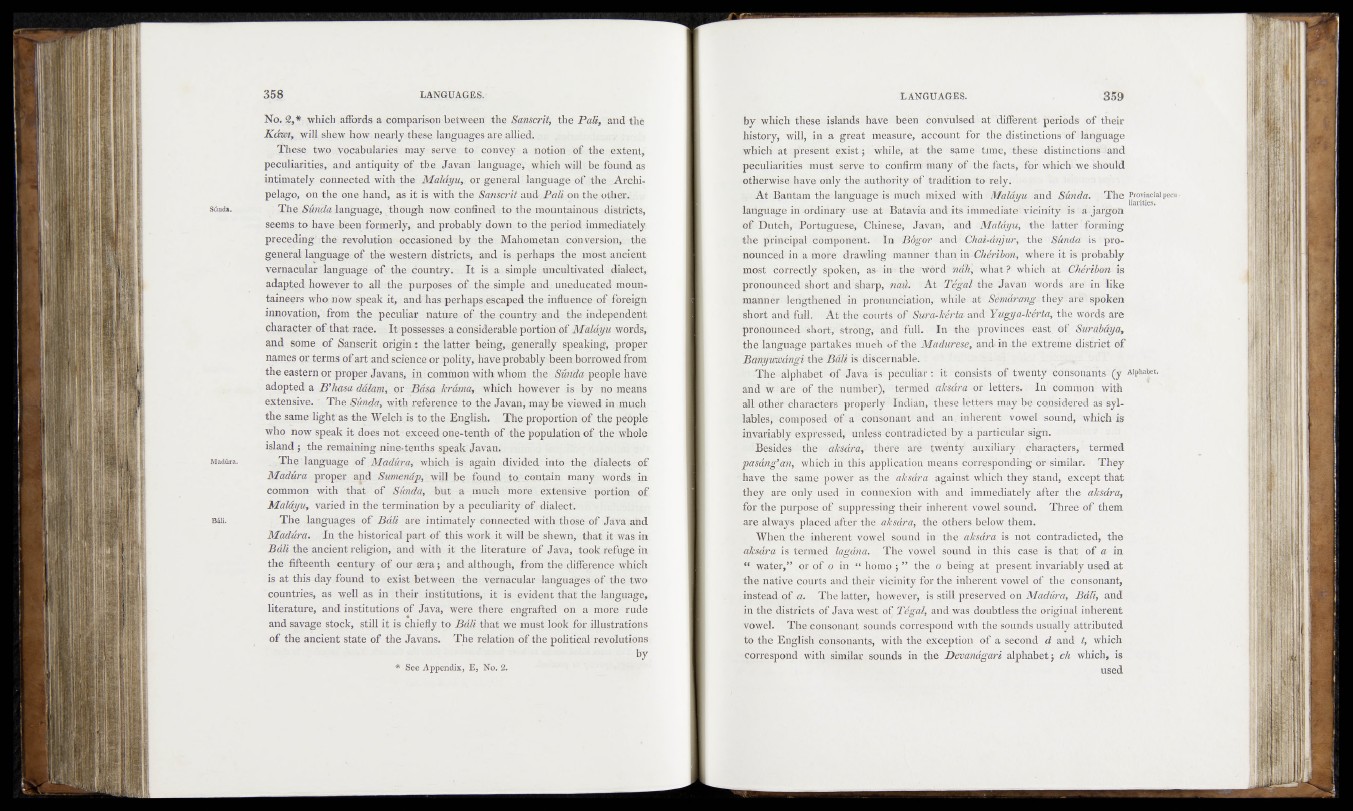
No, 2,* which affords A cOmparisonbetween' the Sanscrit, the Pali, and the
Kdm, will shew how nearly these languages are.alliedi;<c
These two vocabularies may serve to convey a notion of the extent,
peculiarities, and antiquity of the Javanlanguage, which will he found, as
intimately connected with the Maldyu,. or general language of the -Archipelago,
on the one hand, as it is with theSanscrit and.P4& ontheother.
S6nd*. The.Sftnjda language, though now.confined to the mountainous districts,
seems to have been formerly,, and probably down: to the period immediately
preceding' the revolution occasioned by the Maho me tan, 'con version-, the
general language of the western districts, and is. perhaps -the most ancient
vernacular language of the country;. It is a - simple ’uncultivated dialect,
adapted however to all .the. purposes of. the simple and uneducated mountaineers
who: no w speak it, and has perhaps .escaped the influence of foreign
innovation, from the peculiar natihe. of -'the 'countryr.and the independent
character of that race. It possesses- a considerable portion of Maldyu words,
and some of Sanscrit origin: .the latter being,-, generally speaking, proper
names or terms of art and science or polity, have probably been borrowed from
the eastern or proper Javans, in | common with whom. the! Sunda people have
adopted a B’kasa dalam, or- Basd krarna, winch however is by’ Ux> means
extensive; | The Sunda, with reference to the Javan, may tie viewed, in much
the same light'as the Welch.is to the. English. The proportion .of the pedple
who now speak it does not4 exceeds ofte-tenth of the population of-the whole
island ; the remaining nine-tenths speak Javan.
Madtira. language of Maddrai which is again divided into -the dialects of
Maddra proper and Stimendp, will .be found to; contain many wfords in
common with that of Sundd, but a much" mote Lexfenslve^.portion- of
Maldyu, varied in the termination' by a peculiarity of. dialect'. - 1
B4ii. The languages of Bdli are intimately connected wjth those of Java .and
Madura. In the historical part of this Work«it. will be. shewn, that it was in
Bdli the ancient religion, and with it the literature of Java; took refuge ip
the fifteenth century of our sera; and although, frott the difference which
is at this day found to exist between the vernacular languages of th%(two
countries, as well as in their institutions, it is evident that the language,
literature, and institutions of Java, were there engrafted on a more rude
and savage stock, still it is chiefly to Bdli that we must look for illustrations
of the ancient state of the Javans. The relation of the political revolutions
,:J - by
by which these: islands have been convulsed at "different periods of their
history, will, in a great measure, account for the distinctions'-of language
,iwhfeh;:«it'^esfent’'te|ri®.fei|^i whii,^ at tfeg'oipiiiftllii, these .distinetions^and
peculiarities must serve to’ cOWfir iw-inany I of-the facts,i for whiehAv e- should
.otherwise, have only the authority cof’tradition to tely.r.‘<;>
At Bantam the language<is much mixed1 with * Maldyu -and Sunda. TheProvincialpecu
'" . ’' r . ' , .......................... '."ir , . „ , . . „ _ Harities. language in ordinary use at Batavia, and its immediate" vicinity is-a .jargon
of Dutch, Portuguese, Chinese, Javan, ' and -Maldyuj the'-iatter forming
the principal component. oatids'Chmxdmjiir^athe"1 $dm%£& '4s ‘pronounced
in a more drawling■ -manberbthan, in-Ghdriboii] where it is probably
most correctly spoken, as- in; the wdr d' yi'&h, what?: which- ^t^Gheribm- |s
pronouneed short and sharp, mad} ' the Javan., words are' in dike
manner: lengthened’ in pronunciation,- wMsoatr Semdrangithpy ■ are spoken
short and full. Afrthe cdtiTt&d?ySur(i!-Mr4a> and ’Yjsgya-Mnta,:the words afb
pronouncediishoitj'i’sft'ottgi and Tull. In th e tjpt-ovihcfes> -Cast of Surabaya,
the language partakes much of5 the Madurese, and* in the extreme district of
BariyuwdngirtM& Bdli is discernable.:
vi -The alphabet of -Java ci}£ peculiar : it consists‘of twenty ‘ consonants (y Alphabet,
and w ' are <ef the numbeh);. * termed dksdra x>ki loiters*'-1 '-Inhcomrrion with
albbthdr characters -properly Indian,; those letters may bg cohsideted as syllables,
composed of a^oohsonant1 and an,'inherent vowel sound, which is
invariably'expressed,- unless-contradicted-1 by a particular- sign.
, l!Beside‘S'~:tbe; ■aksdra,- there ate twenty* auxiliary'! characters,. termed.
pasdng’an, which ini' this application means cQiTgs-pOhding' 00similar. They
have the same power as, jRg^ahsdra against which they Stand, except that
f.they are only used in co^peXibn with and immediately .'after the aksdra, .
for the purpose jof suppressing their inherent vowel sound. T]fae0jpf them
are always placed after the aksdra, the others below them.
, When the ^-inherent Vowel sound in the aksdra is* jrot'-contradicted, the
aksdra is termed lagdna. The vowel sound in this ’ cSs'^ft-thaf',- of a in
** water,” or oi o in “ homo ; ” tire a being1 at presentlnyatiably used at
the native courts and their vicinity for the inherent voyel of the consonant;
instead of a.. The latter, however,® still preserved on Madera; Bdli, and
in the districts of Jaya wOst of Tigal, and was doubtless'the origin^llpherent
-^fpwel. The consonant sounds correspond with tfie’^opiids usually attributed
to the English consonants, with the . exception of a and t, which
-correspond with similar sounds in the Deoandgari alphabet ; ~sh which, is
used